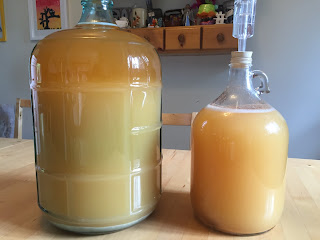The last time I made cider (
see post here), I was failed by
EZ Cap bottles, which just didn't hold any pressure. This resulted in a batch of still cider. Still cider is fine, but I aspire to make carbonated, homemade cider. One of the reasons I wanted to make homemade beer was to get beer to carbonate in the bottles, using standard bottle caps. That worked out just fine (see
Festa Brew "Continental Pilsner). So, it was time to revisit cider-making, and attempt natural carbonation in the bottles.
Tanya and I picked the apples off of our tree, and made the fatal decision that there were enough apples that we could simply cut them up by hand before pressing. That was crazy - the manual labour to cut up all of our apples up into eights (or smaller) was just too much. Next time, I'm going to obtain a fruit crusher like last time.
The pressing however, went fairly well, and we obtained approximately 4 gallons of apple juice. The specific gravity of the apple juice was 1.034, which was almost identical to juice from the last time we pressed apples. To this, I added 4 crushed Campden tablets, 2 tap. yeast energizer, and 1 tsp. of peptic enzyme. After 24 hours, I added a packet of Lalvin EC1118 yeast, by sprinkling it on the surface. Fermentation was well underway a day later.
Primary fermentation proceeded quickly. Four days after adding the yeast, the foam on the surface had collapsed and it was time to transfer to a carboy. The volume (4 gallons) created an opportunity for two separate batches. I siphoned the bulk of the cider to a 3 gallon carbon and placed an airlock on it. This batch is meant to be regular cider.
Spiced Cider
The remainder (which amounted to a little over 1/2 gallon) went into a 1 gallon jug which I topped up with distilled water to which I had added 1 cup of sugar. This was done to get the alcohol level up to where it should be. If I did not add any more sugar, this would have been a 1:2 dilution, and the cider would be very weak). I also added 1/4 tap of nutmeg and two cinnamon sticks for flavour. I sealed the jug with an airlock.
 |
| Regular cider (left), and spiced cider (right). Fine solids are settling out. |
After four days in the carboy, fermentation of the regular cider was virtually complete, and the bulk of the fine solids had settled. It was time to add priming sugar and bottle! So, I siphoned the cider to a large pail, added 3/4 cup of dextrose, stirred thoroughly, and bottled it just like you would beer. The yield was 4 x 1 L bottles, and 22 x 330 mL beer bottles.
I bottled the spiced cider one day later, adding 1/4 cup of dextrose to the (approx.) 1 gallon of spiced cider. Yield was 10 x 355 mL bottles.
A taste test of the spiced cider revealed a beverage that tasted like Christmas. The nutmeg and cinnamon paired well with the apple and the little bit of sweetness from the priming sugar. It remains to be seen how the spices affect the taste when the cider is carbonated and dry. I can't wait!
According to the purple "Winemaker's Recipe Handbook", you should age the cider for three months!!! This seems like a long time. I might get impatient and open a bottle in a month or so, just to see how it's coming along.

